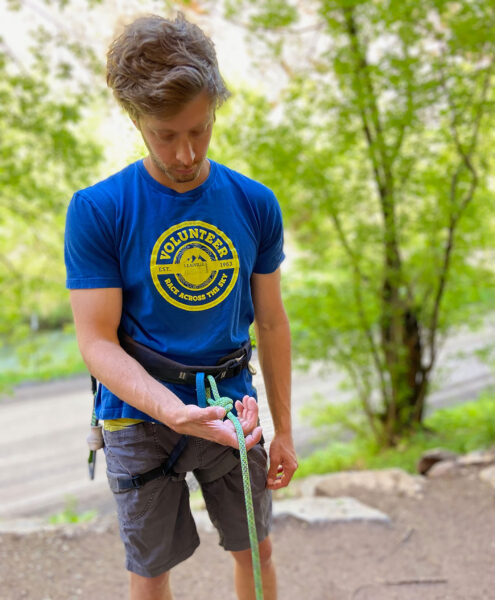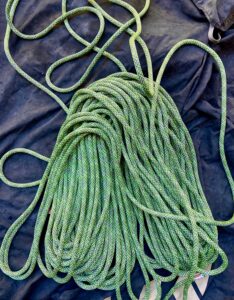
Image by Lucie Hanes
Climbers know that if you’re not falling, you’re not trying hard enough. Wear your whippers with pride, my friends; they’re a sign of effort in action, and there’s no better step to take toward sending than giving it your all.
So if you want to do it right, you’re going to need a workhorse of a rope to get you through the hangdog stage of the projecting process. But even the burliest ropes wear out before too long. That’s one piece of gear that you don’t want to compromise on. Playing games with the lifespan of your rope only adds undue risk to the situation. When in doubt, retire it.
It follows that hardworking climbers go through a lot of rope. Take all the climbers you see at your local crag on any given Saturday and imagine that each pair replaces their rope every other year (if we’re being generous; big whips might send a rope to the grave over the course of just one season). Now multiply that times every crag in the world. That’s a lot of ropes.
Not only that, but that’s a lot of rope waste. Manufacturing so many ropes, in so many varieties, requires an abundance of raw material in certain quantities. Each spool of rope, for example, calls for a specific amount of yarn in specific colors. Anything remaining gets tossed. I’d be willing to bet that the leftovers add up to create nearly as much waste as the ropes themselves, once they’re toast.

Image courtesy of Lucie Hanes
Rather than accept such waste as an unavoidable byproduct of the process, Mammut came up with a way to give all those bits and pieces a better home than the landfill. They realized that uniform colors and patterns don’t serve much of a purpose beyond branding. Standardized design was to blame for the leftovers. But who’s to say they’re really worthless?
Not Mammut. The brand takes the leftovers from the production process and creates new ropes from the recycled yarn.
It’s important to note the trade-off at play here. Some ropes are immediately identifiable from across the crag. Most climbers will recognize the hot pink pop of a Maxim Glider, for example, or the Rasta pattern of Sharma’s Sterling Velocity. Not so with the recently released “Crag We Care” rope from Mammut. Every single cut of rope boasts its own unique color and pattern based on whatever scraps happen to be lying around. That makes it hard to tell from a distance what brand the rope belongs to.
I, for one, applaud Mammut for putting sustainability first here. All too often, environmentalism morphs into yet another marketing ploy for brands. This is a case of the exact opposite. Mammut ultimately bucked branding in favor of a smaller ecological footprint — a rare demonstration of genuine largesse.

Image by Lucie Hanes
Mammut’s altruism shows in the price point, too. The Crag We Care rope comes in at a discount compared to the original Crag Classic. While many brands might try to capitalize on the “green” trend, Mammut opts for honesty. The price reflects the true cost savings of using recycled material.
Beyond looks, the Crag We Care line of ropes mimics Mammut’s bestselling Crag Classic in every way. Sustainability doesn’t come at the cost of performance. It feeds just as smoothly as its predecessor, and gives a nice soft catch from the first use. As someone who weighs a good bit less than my usual belay partner, this is a big one. Most new ropes need a “break in” period to shed the tight, wiry feeling that results in uncomfortably hard falls. By the time it softens up, the rope’s already halfway through its lifespan. I’ve never had that problem with Mammut ropes, and the Crag We Care is no different.
Green is definitely the new black among outdoor industry brands. But Mammut is one of the few to approach the trend without an ulterior motive. Make your next rope a Crag We Care to support a brand that goes green for the right reasons.
Lucie Hanes is an avid writer and adventurer on rock and trail with a passion for sharing her outdoor enthusiasms through journalism and mental strength consultation.
 Your Privacy Choices
Your Privacy Choices
 The
The